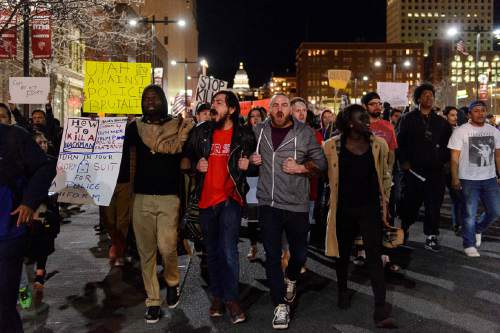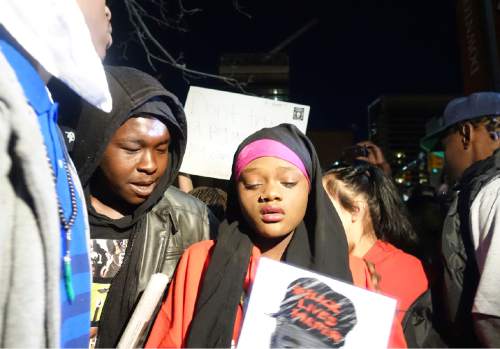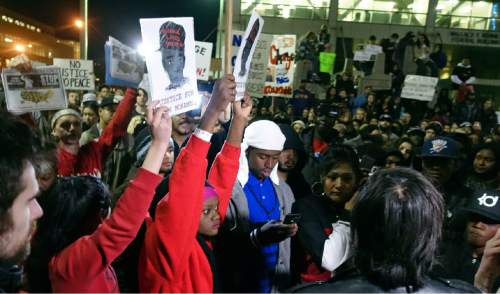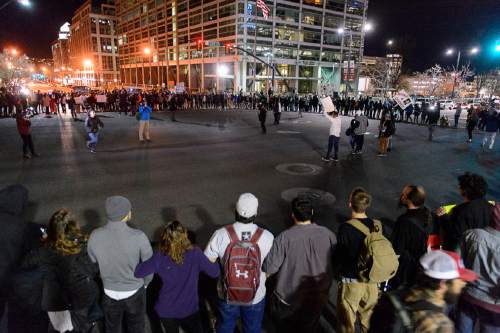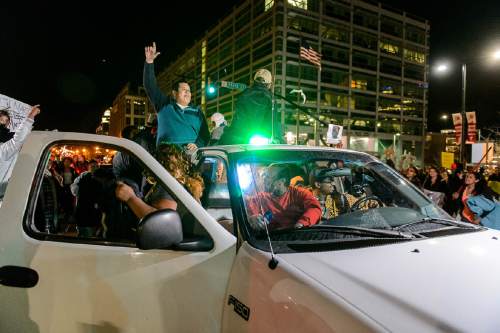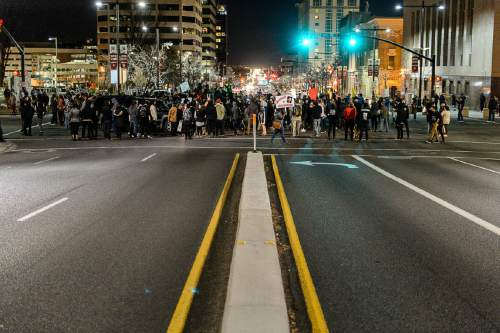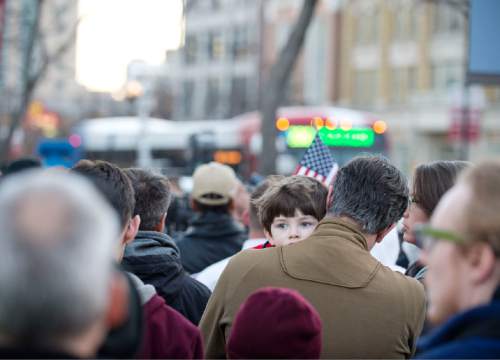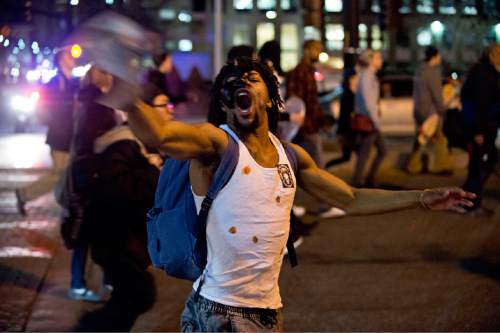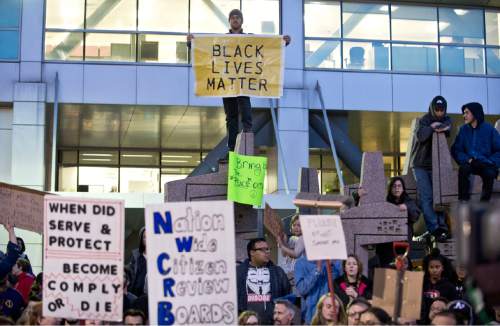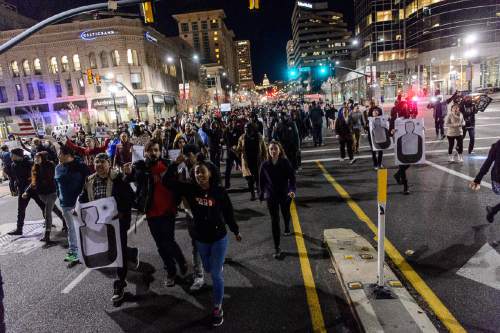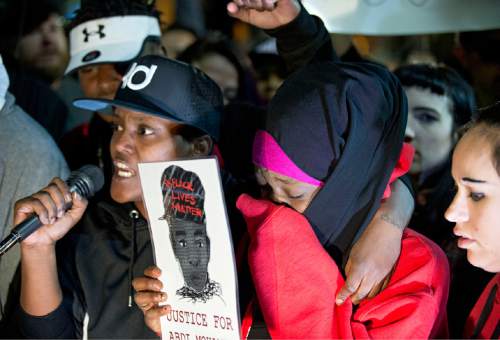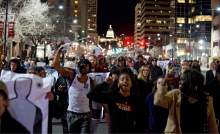This is an archived article that was published on sltrib.com in 2016, and information in the article may be outdated. It is provided only for personal research purposes and may not be reprinted.
Police administrators met Monday with the family of a 17-year-old boy who was critically injured in a shooting by police that led to a confrontation between officers and civilians Saturday in Salt Lake City.
"This is a tragic situation, and we are so sorry," Salt Lake City's interim police Chief Mike Brown tearfully recalled telling the mother of Abdullahi Omar Mohamed as he escorted her to her son's hospital bed.
Mohamed was one of two people police said they saw "with metal objects, attacking a male victim" Saturday night near 250 South Rio Grande St. (440 West), which is near a homeless shelter.
"Officers confronted the two suspects and ordered them to drop the weapons," police wrote in a statement Sunday. "One of the males complied and dropped the weapon, the other continued to advance on the victim and was shot by officers."
Mohamed's family released his name Monday, though Brown would not confirm it and remained silent on many details about the shooting in a meeting with reporters Monday. Brown also would not discuss statements by Mohamed's friend, who said he witnessed the shooting. Selam Mohammad, 19, said Mohamed was in a confrontation with another person and was holding part of a broomstick at his side when officers ran up.
"They told him to put it down, once," Mohammad said, and "started shooting him as soon as he turned around." Mohammad said the police fired four times and that the teenager was hit in the chest and stomach. Brown would not discuss Mohamed's condition.
Two officers were on leave Monday, pending investigations, Brown said.
The shooting took place on a busy Saturday night with multiple special events in the neighborhood. After the shooting, Tribune journalists saw onlookers shouting at the officers, and some threw rocks and bottles. The officers radioed for help, and nearly 100 officers from various agencies descended on the scene, some with riot shields and assault rifles.
The scene was cleared within 10 minutes, Brown said.
"I am happy that in a time of crisis, our brothers and sisters came down to help us," Brown said. "It's always nice to have numbers so that we can safely defuse the situation."
However, he said, "the fabric of this community is torn."
"Relationships are tense," Brown said. "In situations like this, the community pays a great price. The police department pays a great price. The police officers who were involved in this paid a great price. The mother ... and her son paid a great price."
On Monday night, about 500 protesters rallied downtown to air their grievances against the shooting. Gina Thayne, an aunt of Dillon Taylor, and Heidi Keilbaugh, the partner of James Barker, were among the speakers. Salt Lake City police shot Taylor in 2014 and Barker in 2015; the Salt Lake County District Attorney's Office ruled both shootings justified.
"Families are being traumatized. We're being criminalized. We're being wounded, and we're being killed," said Thayne, who questioned how a 17-year-old can be a threat with a broomstick. "Unacceptable. We cannot allow this type of tragedy to continue."
During the protest, Mohamed's friends and family told the crowd that Mohamed has come out of a coma and is improving, and they asked that people keep him in their prayers.
After several speeches at the Wallace F. Bennett Federal Building near 100 South State Street, the protesters marched onto State Street, shouting "Black lives matter" and "Hands up, don't shoot."
While police provided traffic control, the protesters marched to the Public Safety Building at 475 S. 300 East, then back to the Federal Building. There, they blocked the intersection until dispersing at 8:30 p.m.
Brown said he is meeting with several advocacy groups dealing with diversity and police reform, including the NAACP and Utah Against Police Brutality.
Salt Lake City Police will not be releasing the officers' body camera footage while Unified Police are conducting investigations into the shooting, Brown said, describing the videos as UPD's evidence. New countywide protocols require that each shooting by police be investigated by an agency apart from the officers' own employers.
The police body cameras likely were not the only ones rolling at the time of the shooting, Brown confirmed. He said he believes investigators are reviewing footage from multiple security cameras on Rio Grande Street.
The refusal to release the body camera footage prompted objections from the national Council on American-Islamic Relations, or CAIR, which in a media statement identified Mohamed as a Muslim.
"Because of past unfortunate incidents of controversial police shootings nationwide, the release of the body camera video could help allay community concerns about transparency and accountability," said Nihad Awad, CAIR's national executive director.
Salt Lake City Mayor Jackie Biskupski, who has viewed the body camera footage, noted in a Sunday statement that this "is the third significant use-of-force incident for the Salt Lake City Police Department in the last month."
Biskupski said she had that morning "had a serious conversation with police Chief Brown and members of his team to review details about each of these incidents, including a discussion on training and whether de-escalation efforts could have been implemented. These conversations will continue in the weeks to come, will include members of the community and must result in meaningful change."
At least five separate investigations of the Saturday night shooting are pending, Brown said, including reviews by UPD; internal affairs and training units with Salt Lake City police; the city's civilian review board; and Salt Lake County District Attorney Sim Gill, who will determine whether the shooting was legally justified.
Brown would not disclose whether he believes the shooting was justified, but he said it will be reviewed with a critical eye to departmentwide policy.
"As we come together as a police department and a community, we can forge forward [with] changes, whatever we need to do to make this department better," Brown said. "Any organization who thinks they've figured out police work has made a mistake."
The shooting is the first since the department formed its Citizen Advisory Board, which comprises several diversity advocates and other community representatives.
Brown and the board's chairman, University of Utah professor David Parker, visited Mohamed's home Sunday for a meeting with his extended family.
The family appeared "sad and angry," Parker said, and they communicated through body language "the distrust they had upon us walking into the room because of what's happened."
By the end of the meeting, which was facilitated by a translator, some members of the family offered hugs, Parker said.
"Watching that physical transformation was unbelievable," said Parker, who works as a consultant on "inclusive communities."
According to The Associated Press, the family are refugees who came to the United States in 2004.
At Monday night's protest, Thayne pointed out that Brown and Biskupski reached out, which represents change: "Because that's a bigger courtesy than what my family received. They're showing empathy. So these are baby steps. And it takes all of us to continue these steps."
The Salt Lake Police Association called Saturday's shooting "tragic," and it said the two officers were "good officers" who reacted to a fight near the homeless shelter where two men were attacking a third person.
"This case is not about race," the association said in a statement. "They acted in defense of an innocent party. Unfortunately, one of the individuals was shot in the process after failing to obey commands to drop his weapon."
The police association said it will wait to comment further about the incident until UPD completes its investigation, but it added that it welcomes any additional training and would like to work with city leaders to deal with "the longstanding issues near the shelter."
"The violence around the shelter has increased over a long period of time," the statement reads. "It will take sustained leadership to overcome, and we hope to be part of that process."
The City Council released a statement Monday, saying it may support paying for an outside party to investigate such use-of-force incidents. It said it would discuss the role of the civilian review board Tuesday.
Parker and Brown denied characterizations by national media outlets that the confrontation between civilians and police after Saturday's shooting was a "riot."
"What occurred was not a riot," Parker said. "What occurred was a spontaneous reaction to something that had happened. There was no property damage, there was no [injury], there were no cars turned over."
The ACLU of Utah defended bystanders who engaged police without violence.
"We understand why community members felt anger in response to the shooting," the group wrote in a statement Monday. "... That there would be brief unrest in response to such an incident was fairly predictable."
Brown confirmed that no officers reported injuries in the confrontation.
Also Monday, state court officials released Mohamed's juvenile court records, which show that the teen has incurred 12 delinquency offenses since 2010, when he was 12 years old.
There are four felonies and eight misdemeanors listed on his intake history, which include third-degree-felony counts of aggravated assault with a weapon, theft and retail theft, as well as lesser crimes of criminal trespass, criminal mischief, and using a dangerous weapon.
The records show Mohamed has spent 122 days in a detention facility and 583 days on probation.
—Tribune reporter Jessica Miller contributed to this story.


